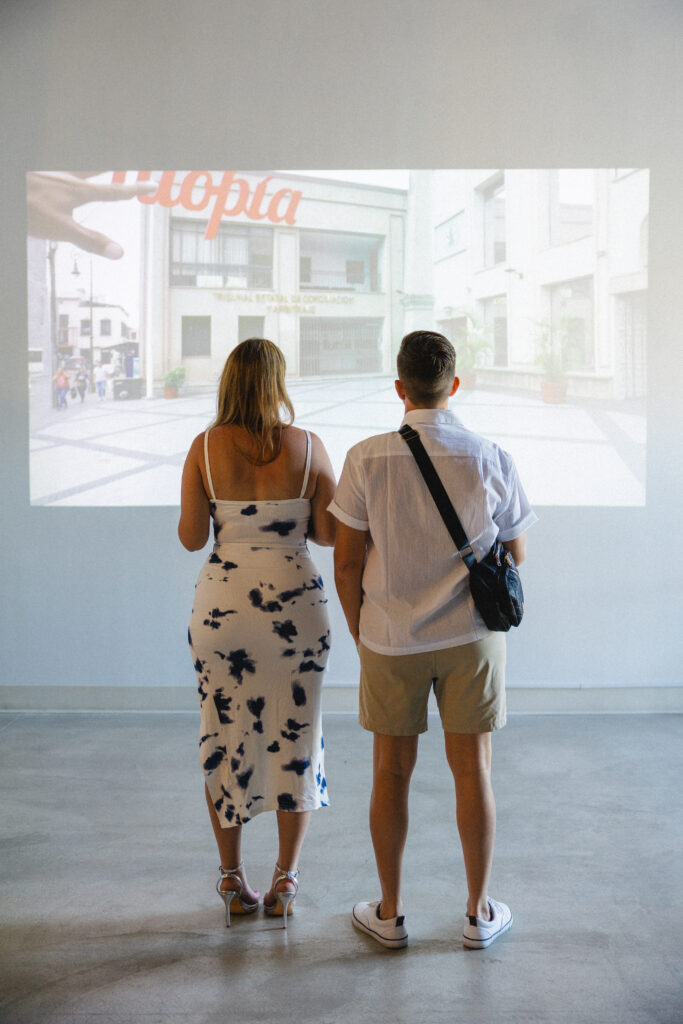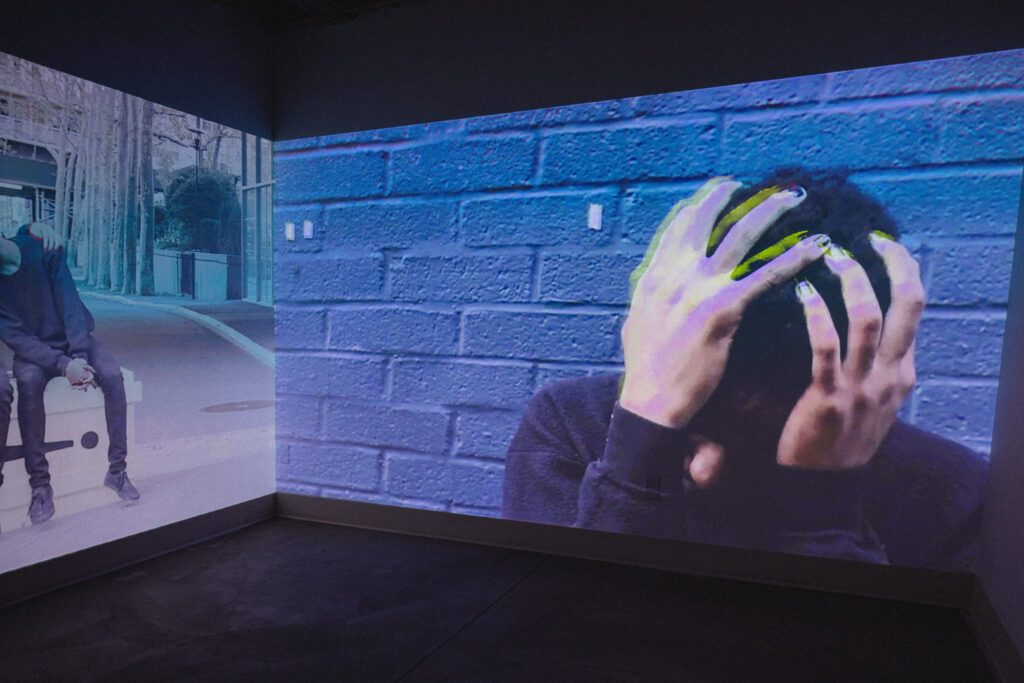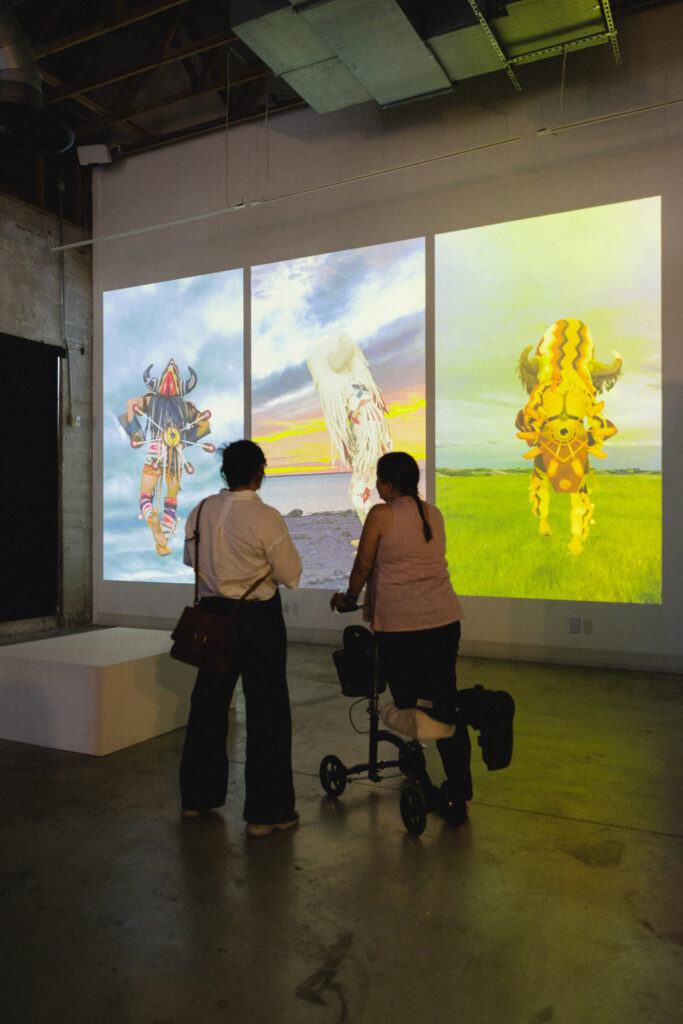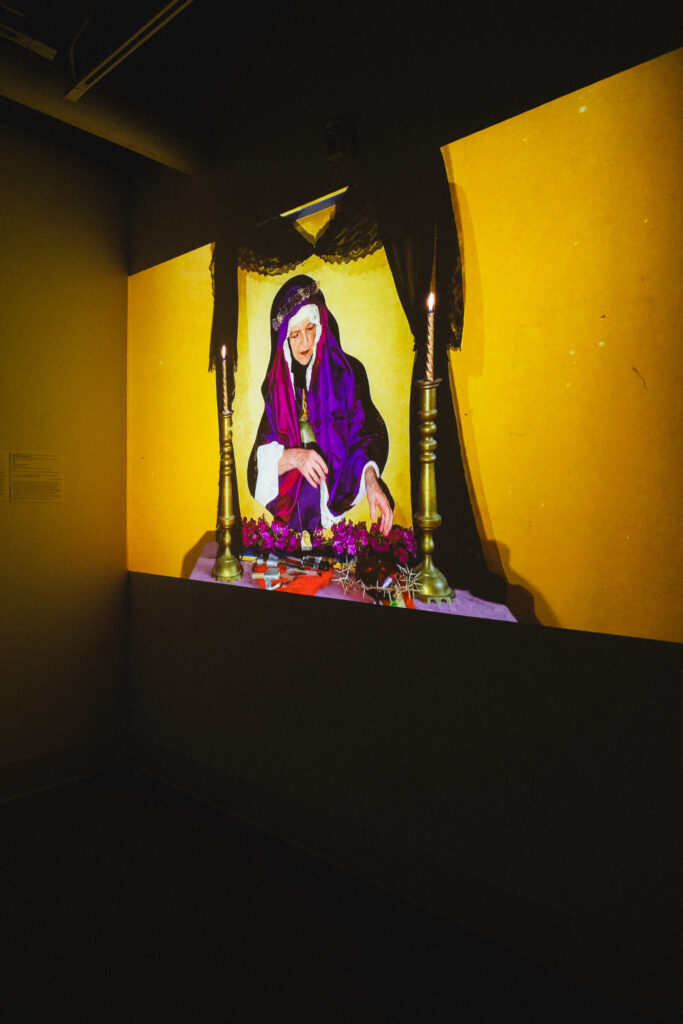When many arts organizations turned to video during the COVID-19 pandemic shutdowns as a means of staying visible and demonstrating that fresh forms of creative expression could still thrive, many artists found ways to merge cinematography with their media and disciplines. In contemporary dance, as an example, video primarily had been used for archiving and documenting choreography to ensure movement languages and vocabulary were not lost due to dance’s historically ephemeral nature.
However, the genre of screendance has challenged those choreographic conventions when it comes to the video camera. Just seven minutes long, Rachel Barker’s Sedimented Here (2022) melded two of Utah’s most substantial strengths in creative expression – dance and documentary filmmaking. Barker’s cinematic-choreographic statement, filmed in Moab, synthesizes the visceral athleticism of dance with the pristine beauty of the otherworldly red rock landscape that tempts and lures many to Utah. But, something even more consequential emerges from the film for anyone who visits, absorbs and engages with this extraordinary desert landscape. Our place and presence should not compromise nor diminish the dignity and integrity of this natural wonder.
The same breadth and depth of impetus with video is found in (Im)Posibilidades: Performance Art for Video, an exhibition at Ogden Contemporary Arts (OCA) highlighting artists who create performances explicitly for the camera. These works exist as full-fledged video art pieces rather than archival records, embracing digital technologies and drawing inspiration from time-based media traditions, from cinema to TikTok dance culture. The 14 artists, who come variously from the U.S. and Mexico, have produced pieces that touch on colonialism, Indigenous identity and community, slavery, discrimination, stereotypes of gender and socioeconomic consequences of marginalization, environmental degradation, gentrification and cultural censorship and suppression.
The variety of video works, ranging in length from a couple of minutes to more than 18 minutes, is a marvelous sampling of cinematic treatments. There are several examples that could be found at a top-rated international short film festival. Some are conceptual and abstract video art pieces while others are framed within clear, well articulated social critiques. Some are shot straightforward while others incorporate visual effects to produce surreal elements. It is well worth taking the time to view each piece from start to finish.
The exhibition was organized by Stephanie García and Peter Hays (PROArtes México) who worked with guest curator Adam Forrester. The exhibition, which is open through Oct. 12, features artwork by: María Eugenia Chellet, Naomi Rincón Gallardo, Jarrett Key, Beth Krensky, Cannupa Hanska Luger, Leo Marz, Jillian Mayer, Lilly McElroy, Ileana Moreno, Kameron Neal, Javier Ocampo, Yoshie Sakai, José Villalobos, and Kristan Woolford.
José Villalobos’ El Peso Del Rio (The Weight of the River) (2021, 13 minutes) touches incisively on the theme of migration as a natural phenomenon that supersedes the unnaturally constructed logic that humans impose on borders. The artist’s performance vividly replicates the enormous gravity and inhospitable conditions immigrants must endure in crossing the Rio Grande and navigating the Chihuahuan and Sonoran deserts, in order to seek refuge, asylum and safety in order to live their identities authentically and comfortably.
Likewise, Lilly McElroy’s trio of short videos (The Sun in my Hand, 1, 3 minutes; The Sun in my Hand, 2, 2 minutes, 2023; A Woman Runs Through a Pastoral Setting, 2014, 1 minute) emphasizes nature’s preeminence in the American West that defies the human urge to control every aspect of land by compromising its sustainability and preservation while also trying to govern by laws that ignore and reject the essential and biological nature of gender and individual identity.
As with Villalobos and McElroy, Javier Ocampo’s Utopía (2019, 3 minutes) triumphs in resilience even if the visuals initially might dissuade some as a futile exercise. With a literal element in hand, Ocampo is chasing the ‘Utopía’ word around the Justice sculpture in front of the Palace of Justice in Morelos, Mexico. While it was Dr. Martin Luther King, Jr., who made popular the line about the moral universe’s arc eventually bending toward justice, the reference came from Theodore Parker, an American abolitionist minister, who spoke in a sermon in the 1850s: “I do not pretend to understand the moral universe; the arc is a long one, my eye reaches but little ways. I cannot calculate the curve and complete the figure by the experience of sight; I can divine it by conscience. But from what I see I am sure it bends towards justice.” Ocampo’s video exemplifies the universal objective of perseverance for utopian justice.

In a surrealistic style reminiscent of Luis Buñuel’s mid-century Mexican films, María Eugenia Chellet’s La Dolorosa (Our Lady of Sorrows in the time of Covid-19, 4 minutes, 2020) is a magnificent kitschy video piece emphasizing the timeless centrality of the Virgin Mother in Mexican culture, education, devotion and contemporary life. Chellet, former professor of Political and Social Sciences at National Autonomous University of Mexico, is a pioneer in the multidisciplinary study of kitsch, photonovellas and anti-advertising. Chellet is a keynote speaker tomorrow for an exhibition-related symposium at Weber State University.
Leo Marz’s Old Stories for Young Readers [Historias Viejas para Lectores Jóvenes, 11 minutes, 2022] is a unique screendance production that featured nine dancers performing site-specific choreography in the Museo Jumex plaza, along with a bronze replica of the index finger of a statue of General Ignacio Zaragoza. That replica was Marz’s Your Deletion Was Successful, “a sculptured image composed by a mural-green screen and a bronze replica of an index finger from a sculpture depicting … Zaragoza. A simple digital touch on the corner –even subtler than a nudge from endless scrolling on Tiktok or when the National Electoral Institute captures your biometric data– disturbs the image, it disputes its bidimensional character and reestablishes it as an object in space.”
With an exceptional sense of hip-hop’s natural capacities for remixing and layering, Kristan Woolford’s Fr33Th@L@nd (2023, 7 minutes) considers Afrofuturism and Afrosurrealism as well as Indigenous futurism in his use of projected image technology. The critique is elucidating as he overlays National Park Service imagery and references the Indian Removal Act of 1830, Andrew Jackson’s portrait and Angola capoeira, the Brazilian martial art.
A short narrative of impressive fantasy worthy for an distinguished international film festival, Eclipse (18 minutes, 2023) by Naomi Rincón Gallardo is riveting for its Mesoamerican imagery of obsidian butterflies, a female vampire, the bleeding tree of life and female demons of the cosmos, respectively representing death, blood, dismemberment and sacrifice that presages a solar eclipse. An excellent companion is Ileana Moreno’s Kowatl y el Mejor Amigo del Sol (Sun’s Best Friend, 2021, 5 minutes) that expands on the mythological and pop cultural parallel representations of allegorical values, themes and their social significance. The point is that while we might relegate traditional myths to oblivion, we should strengthen and sharpen our critical thinking capacity to put modern myths, just as classical myths did, into constructive contexts that enlighten our minds and make our souls more conscious of our actions and relationships.
The capacities of three-channel video, mixed media, upcycled materials and superimposed images are meticulously synthesized in Midéegaadi: Water Bison, Light Bison, Fire Bison (2022, 3 minutes) from Cannupa Hanska Luger’s Future Ancestral Technologies series. Born on the Standing Rock Reservation in North Dakota, Luger is an enrolled member of the Three Affiliated Tribes of Fort Berthold and is Mandan, Hidatsa, Arikara and Lakota. As the artist noted, “The figures of Midéegaadi exist throughout time maintaining a pledge of accountability to the land and waters that have sustained the Buffalo Nation and in turn the human beings.” The video underscores an important point raised by Blaire Morseau, a Michigan State University scholar studying Indigenous science fiction and American futurism: “What makes Indigenous science fiction different from mainstream science fiction is that we’re relying on our own traditional knowledge systems as opposed to just Western science.”

Make Me a Sanctuary (2018, 3 minutes) by Beth Krensky is extraordinarily soothing, as the artist walks along a desolate part of the Great Salt Lake shoreline, part of her sanctuary ritual. She dons a wearable tent made from old cloth sewn together and held up by poles of olive wood. The image recalls the passages of the Book of Exodus 25-31 and 35-40, which describe in detail the inner sanctuary of the Holy of Holies. Krensky epitomizes the characteristics of non-denominational spirituality in her art, which allows her to incorporate familiar objects and representations of faith while emphasizing the individual’s sacred experiences that are wholly unencumbered from dogma or doctrine.
Even in its whimsy, Grandma Nightclub Music Video (2022, 4 minutes) by Yoshie Sakai makes a delightful argument for why marketing and capitalism should not prioritize the joys of youth over those of the silver generations. After all, there are grandmothers who can still enjoy a night out on the town, dancing, socializing and,yes, even twerking. It is a refreshing rebuke to ageism.
For more information, see the Ogden Contemporary Arts website.


